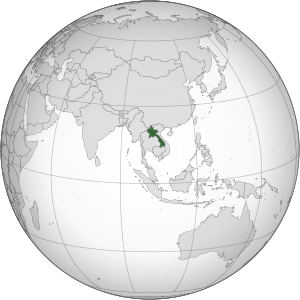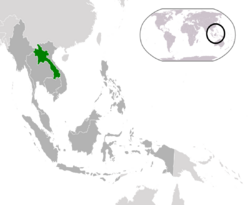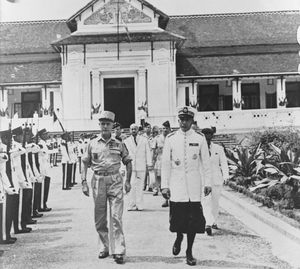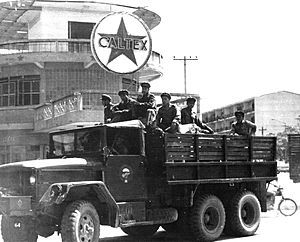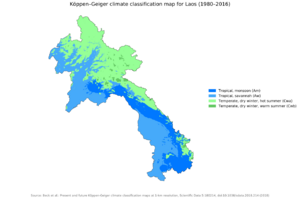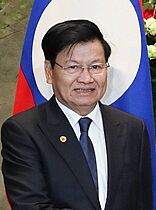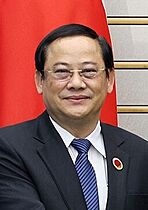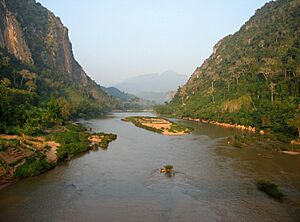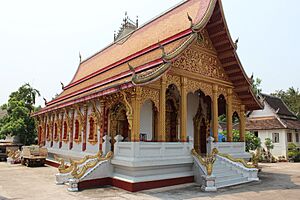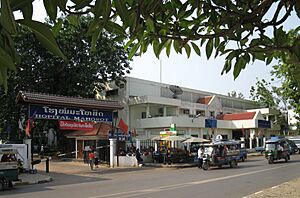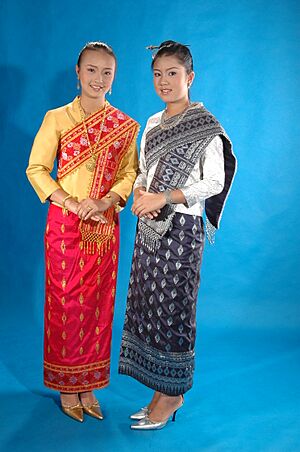Laos facts for kids
Quick facts for kids
Lao People's Democratic Republic
|
|
|---|---|
|
|
|
|
Motto: ສັນຕິພາບ ເອກະລາດ ປະຊາທິປະໄຕ ເອກະພາບ ວັດທະນະຖາວອນ
Santiphap, Ekalat, Paxathipatai, Ekaphap, Vatthanathavon "Peace, Independence, Democracy, Unity and Prosperity" |
|
|
Anthem: ເພງຊາດລາວ
Pheng Xat Lao "Hymn of the Lao People" |
|
| Capital | Vientiane 17°58′N 102°36′E / 17.967°N 102.600°E |
| Official languages | Lao |
| Spoken languages | |
| Ethnic groups
(2015)
|
|
| Religion |
|
| Demonym(s) |
|
| Government | Unitary Marxist–Leninist one-party socialist republic |
| Thongloun Sisoulith | |
| Bounthong Chitmany Pany Yathotou |
|
| Sonexay Siphandone | |
| Legislature | National Assembly |
| Formation | |
| 1353–1707 | |
|
• Kingdoms of Luang Prabang, Vientiane & Champasak
|
1707–1778 |
|
• Vassals of Siam
|
1778–1893 |
|
• French protectorate
|
1893–1953 |
|
• Free Lao Movement
|
1945–1949 |
|
• Unified Kingdom
|
11 May 1947 |
|
• Independence
from France |
22 October 1953 |
|
• Monarchy abolished
|
2 December 1975 |
| Area | |
|
• Total
|
236,800 km2 (91,400 sq mi) (82nd) |
|
• Water (%)
|
2 |
| Population | |
|
• 2022 estimate
|
7,749,595 (103rd) |
|
• Density
|
26.7/km2 (69.2/sq mi) |
| GDP (PPP) | 2023 estimate |
|
• Total
|
|
|
• Per capita
|
|
| GDP (nominal) | 2023 estimate |
|
• Total
|
|
|
• Per capita
|
|
| Gini (2012) | 36.4 medium |
| HDI (2022) | medium · 139th |
| Currency | Kip (₭) (LAK) |
| Time zone | UTC+7 (ICT) |
| Driving side | right |
| Calling code | +856 |
| ISO 3166 code | LA |
| Internet TLD | .la |
Laos, officially called the Lao People's Democratic Republic (LPDR), is a country in Southeast Asia. It is the only country in this region that does not have a coastline. Laos shares borders with Myanmar, China, Vietnam, Cambodia, and Thailand. Its capital and largest city is Vientiane.
Laos's history goes back to the kingdom of Lan Xang, which means 'million elephants'. This kingdom existed from the 13th to the 18th century. Because of its location, Lan Xang became an important place for trade. After some conflicts, the kingdom split into three smaller kingdoms. In 1893, these three kingdoms were brought together under French rule. Laos gained full independence in 1953.
After a civil war, the Lao People's Revolutionary Party took control in 1975. They established a one-party socialist republic. Today, Laos is working to grow its economy by generating electricity from its rivers and selling it to neighboring countries. It also aims to become a "land-linked" nation with new railways connecting it to its neighbors. The World Bank sees Laos as one of the fastest-growing economies in Southeast Asia.
Contents
Understanding the Name of Laos
The name Laos was created by the French. They united the three Lao kingdoms in 1893. The name is similar to the plural of the main ethnic group, the Lao people. In English, the "s" in Laos is pronounced, not silent.
History of Laos: A Journey Through Time
Ancient Times: Early Humans and Farming
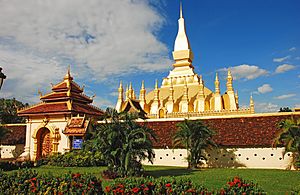
Scientists found a human skull in a cave in northern Laos that is at least 46,000 years old. This makes it the oldest modern human fossil found in Southeast Asia. Early people in Laos used stone tools. Around 4000 BC, people started farming. Later, around 1500 BC, bronze objects appeared, and iron tools were used by 700 BC. People speaking Tai languages moved into the areas of Laos and Thailand between the 8th and 10th centuries.
Lan Xang Kingdom: The Land of a Million Elephants
Laos's history began with the kingdom of Lan Xang, founded in the 13th century by Prince Fa Ngum. He conquered many areas along the Mekong River and made Theravada Buddhism the official religion. After his rule, the kingdom faced conflicts for nearly a century.
In 1520, King Photisarath moved the capital to Vientiane to avoid invasions. Later, King Setthathirath ordered the building of Pha That Luang, a famous monument. After his disappearance, the kingdom faced more instability. In 1637, King Sourigna Vongsa expanded the kingdom. When he died without an heir, Lan Xang split into three smaller parts.
French Rule: Laos as a Protectorate (1893–1953)
In the 19th century, French forces arrived in Laos. They united the three Lao kingdoms and made Laos a French protectorate in 1893. Vientiane became the capital again. Laos produced goods like tin, rubber, and coffee for France.
During World War II, Laos was occupied by Japan. After the war, some Lao nationalists declared independence. However, French troops returned and gave Laos some self-rule. In 1950, Laos became an "associated state" within the French Union. Finally, on October 22, 1953, Laos gained full independence as a constitutional monarchy.
Independence and Modern Laos (1953–Present)
After independence, a civil war began in Laos in 1959. The communist group called the Pathet Lao, supported by North Vietnam and the Soviet Union, fought against the Royal Lao Army, which was supported by the United States.
Laos was also affected by the Vietnam War. Parts of Laos were used as supply routes. In response, the United States dropped many bombs on Laos between 1964 and 1973. This made Laos the most heavily bombed country in history compared to its population size. Many of these bombs did not explode and still remain scattered across the country, causing harm to people. Laos has been a strong supporter of banning these types of weapons.
In 1975, the Pathet Lao took control of the country. They ended the monarchy and renamed the country the Lao People's Democratic Republic. The new government formed close ties with Vietnam.
In recent years, Laos has focused on development. A major railway line, the Boten-Vientiane railway, opened in 2021. This railway connects Laos to China and is part of a larger project to link countries through trade.
Geography of Laos: Mountains, Rivers, and Plateaus
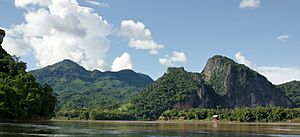
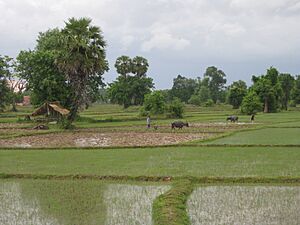
Laos is a landlocked country in Southeast Asia. Its landscape is mostly mountains, with the highest peak being Phou Bia at 2,818 meters (9,245 feet). There are also some plains and plateaus. The Mekong River forms part of Laos's western border with Thailand. The Annamite Range mountains form most of the eastern border with Vietnam.
Climate in Laos: Rainy and Dry Seasons
Laos has a tropical climate, influenced by monsoons. There is a rainy season from May to October. This is followed by a dry season from November to April. Locals often describe three seasons: rainy, cool, and hot.
Wildlife in Laos
Laos is home to diverse wildlife, including many unique species. Its forests and rivers provide habitats for various animals.
Administrative Divisions: How Laos is Organized
Laos is divided into 17 provinces and one special area for the capital city, Vientiane. These provinces are further divided into districts and then into villages.
|
An updated map of Lao provinces (from 2014) |
|---|
Politics and Government in Laos
Laos is a socialist state that openly supports communism. The only legal political party is the Lao People's Revolutionary Party (LPRP). The leader of this party, called the General Secretary, holds the most power in the country.
Laos adopted its first constitution in 1947, declaring itself an independent state. In 1975, after the civil war, a new constitution was adopted. This constitution, updated in 1991, gives the LPRP a "leading role" in the country's government.
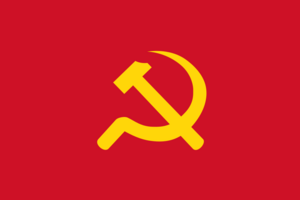
Economy of Laos: Growth and Development
Laos's economy relies heavily on trade and investments with its neighbors: Thailand, Vietnam, and China. China is the biggest foreign investor in Laos. Thailand and Vietnam are also major investors.
Farming, especially subsistence agriculture (farming just enough for your family), makes up half of the country's economy. It also provides jobs for 80% of the people. Rice is the main crop, grown on about 80% of the farmland. Laos has many different types of rice.
Laos imports oil and gas. The country also has many mineral resources like coal, gold, and copper. The government wants to attract more foreign companies to develop these resources. Laos also uses its rivers and mountains to produce and export a lot of hydroelectric energy.
Laos is working to improve its economy and the lives of its people. It is classified as a least developed country by the United Nations. However, it has been one of the fastest-growing economies in Southeast Asia.
Tourism in Laos: Exploring Ancient Sites and Nature
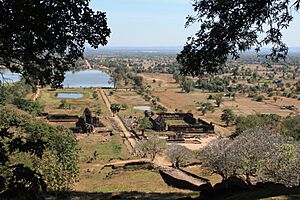
Tourism in Laos has grown a lot. In 1990, about 80,000 international visitors came to Laos. By 2010, this number grew to over 1.8 million. Tourism creates many jobs in the country.
Laos is known for its beautiful architecture and rich history. The country is also developing ecotourism. This type of tourism focuses on visiting natural areas in a way that protects the environment and supports local communities.
Transportation in Laos: Rivers, Roads, and Railways
Laos's mountainous land made it hard to build roads and railways in the past. Its first railway line, a short 3-kilometer track connecting Vientiane to Thailand, opened in 2009. In December 2021, a much longer railway, the Boten–Vientiane railway, opened. This 414-kilometer line connects the capital, Vientiane, to the northern border with China. It is a key part of China's Belt and Road Initiative.
Most households in Laos have a telephone, either a landline or a mobile phone. Electricity is also available to most of the population.
Water Supply and Sanitation
Laos has made good progress in providing clean water and sanitation to its people. More people in rural areas now have access to improved sanitation facilities. The government is working with private companies to further improve water services.
People and Culture of Laos
Ethnic Groups: A Diverse Population
The people of Laos are often grouped by where they live: lowlands, midlands, and highlands. This often matches their ethnic group. More than half of the population are ethnic Lao people, who live in the lowlands. They speak a Tai language. These lowland people are called Lao Loum.
In the central and southern mountains, you'll find Mon-Khmer-speaking groups, known as Lao Theung (mid-slope Laotians). They are the original people of northern Laos. They make up about 30% of the population.
Hill people and minority cultures like the Hmong and Yao live in isolated mountain regions. These groups are known as Lao Sung (highland Laotians) and make up about 10% of the population.
Languages Spoken in Laos
The official language is Lao. More than half of the people speak Lao as their first language. Others, especially in rural areas, speak ethnic minority languages like Khmu and Hmong. The Lao alphabet developed between the 13th and 14th centuries.
French is still used in government and business. Laos is a member of the French-speaking organization La Francophonie. English is also becoming more popular, especially because Laos is part of ASEAN.
Religion in Laos
Most Laotians (66%) practice Theravada Buddhism. About 30% follow traditional Lao folk religions. There are also smaller groups of Christians and other religions.
Health and Education in Laos
In 2017, the average life expectancy in Laos was about 62.6 years for males and 66.7 years for females. The government spends about 4% of its GDP on health care.
The ability to read and write, or literacy, has improved in Laos. In 2017, the literacy rate for adult women was 62.9%, and for adult men, it was 78.1%. In 2004, 84% of children were enrolled in primary school.
Culture of Laos: Traditions and Celebrations
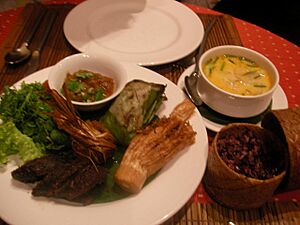
Sticky rice is a very important food in Laos. It is a staple food, meaning it's eaten almost every day. There are many traditions and rituals connected to growing rice.
Lao Cinema: Films and Documentaries
The first full-length film made after the monarchy ended was Gun Voice from the Plain of Jars in 1983. More recently, films like Sabaidee Luang Prabang (2008) have been made. The documentary Blood Road (2017), filmed mostly in Laos, won an Emmy Award.
Lao films are gaining international attention. The Rocket (2013) won three awards at the Berlin International Film Festival. Chanthaly (2013) was shown at Fantastic Fest. In 2017, Laos submitted Dearest Sister to the Academy Awards, marking its first Oscar submission. As of 2018, Laos has three movie theaters.
Festivals and Celebrations in Laos
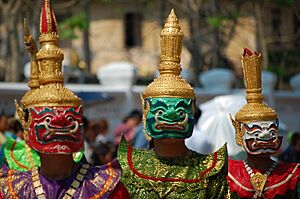
Laos has many public holidays, festivals, and ceremonies throughout the year. Some of the main ones include:
- Hmong New Year (Nopejao)
- Bun Pha Wet
- Magha Puja
- Chinese New Year
- Boun Khoun Khao
- Boun Pimai (Lao New Year)
- Boun Bang Fai (Rocket festival)
- Visakha Puja
- Khao Phansaa
- Haw Khao Padap Din
- Awk Phansaa
- Bun Nam
- Lao National Day (December 2)
Sport in Laos
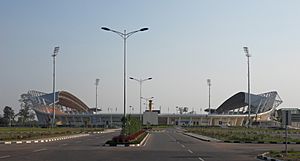
The national sport of Laos is muay Lao. It is a type of kickboxing, similar to muay Thai from Thailand.
Images for kids
See also
 In Spanish: Laos para niños
In Spanish: Laos para niños




